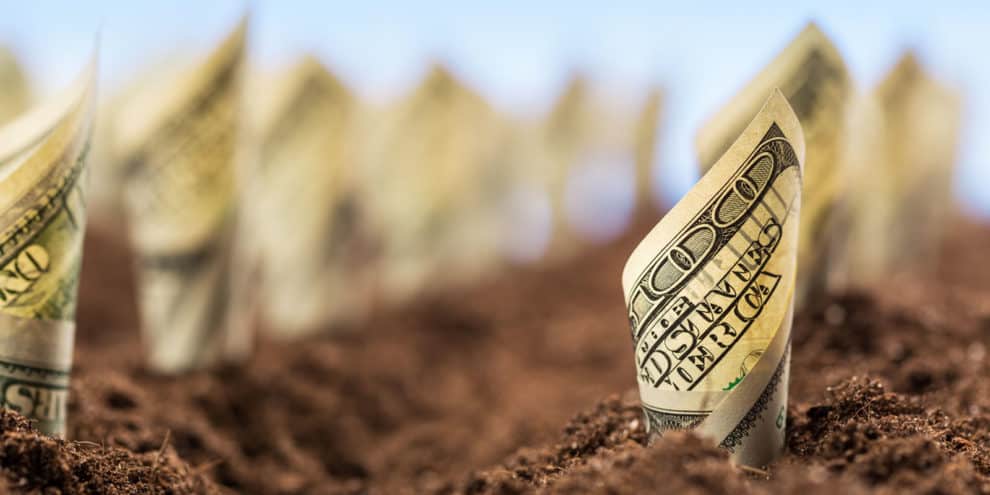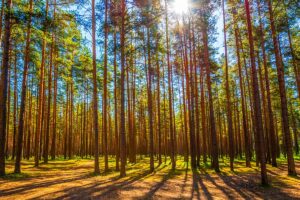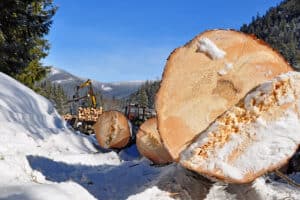I have a rule against giving my time away for free, which I am trying to enforce more diligently than when I was 30 when I had more time to give away.
An appraiser called last week with a question that snagged me before I gathered my remaining wits enough to start charging. He asked: “How do you determine the bare-dirt value of timberland?”
As with so many other questions that arise as you get older, there’s no easy or simple answer.
Bare dirt doesn’t exactly have a clear definition in the field, and it is equally fuzzy when trying to put a dollar on it. So let’s say for the purpose of getting started that bare dirt refers to timberland that contains no merchantable timber value and no pre-merchantable timber value. Think of a total clear cut, down to the stumps.
One way to approach the question is to assume that the value of the bare dirt depends on what its next use is. And it’s easier, I think, to value bare dirt if the next use is the same as both its current and immediate past use. Assigning current bare-dirt value on the basis of an assumed future is riskier, because the valuation is more speculative.
If, for example, the bare dirt of a just-harvested pine plantation is to be planted back in pine, I would try to learn how large land-owning, pine-planting companies calculate the intrinsic value of their dirt for growing pine. Local consulting foresters and forest-knowledgeable brokers and appraisers might have a ballpark number at the ready. An individual buyer might also get a straight answer simply by calling three or four such companies to ask how they value bare dirt before it’s replanted.
If this approach is taken, you must remember that size affects value. One acre is priced higher on a per-acre basis than 1,000 acres, even though the acres are identical. So the buyer will have to adjust the raw bare-dirt value information he receives for size.
With most hardwood tracts, bare dirt has different meanings. Most hardwood land is not planted back, though exceptions exist to that generalization. Most hardwood tracts are not farmed as plantations, that is, planted on cleared, open ground, thinned and then clear cut (with some exceptions).
Where a hardwood tract is completely clear cut down to the stumps, the buyer needs to determine what its next use is—planted back in trees, allowed to naturally regenerate into hardwoods, converted to pasture or other agricultural use, developed as second-home property and so on. Each next use involves a different current value for the bare dirt from a buyer’s perspective as well as the seller’s.
Let’s assume that its next use is as a naturally regenerated timber tract, that is, nothing at all is done to the land immediately following the clear cut and no additional money is invested in it. I think the value of this bare dirt at that moment is an intrinsic value, defined by (and limited to) being the “host” for future timber production. I would put no higher value on it than that for which it is being used.
At some point in the future, this land may acquire more value as second-home/recreational property. But it may not. I believe that it is wrong to assume that all timberland is embedded with guaranteed future higher-and-better-use (HBU) value…just because. How far into the future HBU inflation might occur on a particular tract depends on the characteristics of the land itself and market trends, both local and national. For the purpose of immediate valuation, however, I would argue that in most cases no future value of this type should be priced into a current valuation of the bare dirt.
I’ve run into a number of for-sale timber tracts where land represents in the seller’s thinking anywhere from 60 to 80 percent of the asking price, and more than half the land “value” is HBU, whether or not that’s justified by a reasonably objective reading of the local market.
Bare-dirt valuation is often made more complicated when the dirt is not exactly bare.
Many hardwood tracts are selectively cut above a certain diameter — say, for instance, 16” DBH — just prior to being sold. A cut of this sort will leave some merchantable timber value in smaller-diameter sawlogs and pulp as well as pre-merchantable timber in the smallest diameter classes. To get a bare-dirt value, the value of the uncut merchantable timber and the pre-merchantable timber has to be separated out from the valuation of the land alone.
A word of caution. Many hardwood tracts are “high-graded” or “creamed.” This approach to logging harvests only the high-value species in sawlog diameters. Low-value species and saw-log diameter trees that have no merchantable value (owing to poor form, defects and the like) are left standing. High-graded tracts are made less valuable as subsequent timberland properties, because the “junk” trees are left to continue taking resources that would be better used by the young growth in high-value species. In the worst cases I’ve seen after three or four high-gradings, the hardwood tracts have little if any merchantable timber value—just a lot of big trees that are degrading the value of the land for timber production. The intrinsic bare-dirt value of such a high-graded tract is lower than a properly harvested tract because high-graded dirt can’t grow the high-value species that it would otherwise be capable of producing.
A recently high-graded tract is often marketed as a recreational property or large second-home lot, because it looks better than a more severely cut tract (that has been harvested more responsibly for both future timber production and forest health) and can, therefore, be sold at higher price to a different market. As a buyer, I would value this tract as timberland, not HBU land. (The seller is “adding value” by simply renaming the tract “recreational” or “large second-home lot,” instead of calling it, high-graded timberland, which is what it really is unless and until it is sold as something else.)
One way to get at bare-dirt value is to work backward from a fair market appraisal. The appraiser will place a current market value on the target property as a whole based on a comparable analysis of three recent sales of similar and close-by properties. A typical FMV appraisal will not separately value the actual worth of the target property’s merchantable timber. The appraiser will compare recent sales of generic wooded property. With an appraisal value for the entirety, a buyer can have a consulting forester separately value the merchantable timber, leaving a value for the dirt.
This method, however, will not yield an intrinsic value for the dirt. It will yield a value that is calculated from recent sales—each of which may be much higher than the intrinsic value of each property. If your three comps are caviar, your fish egg will be priced as caviar even though it’s just a fish egg and all you want to use if for is bait. Getting a bare-dirt value from inflated comp values used in an appraisal will produce a value higher than the intrinsic value of the bare dirt used for growing trees.
In many cases, you have to come up with some sort of mark-down technique to get an intrinsic value for the bare dirt when you only have an appraisal or a tax-assessed value to use as a starting point for the entirety. Here are some ways that you might triangulate a bare-dirt value from such information:
- Subtract every hard valuation (improvements, merchantable timber, premerchantable timber, minerals) from the entirety’s appraisal value. That will produce a “soft” number that is likely to require further mark down to get to the intrinsic value of the bare dirt for timber-growing purposes, because the comps are likely to be inflated. The amount of the mark down depends on how inflated the comparable values are due to HBU influence.
- Look for sales of bare-dirt woods (no merch timber value) that have been kept as tree-growing tracts. These are the true comps, but there is, of course, no guarantee that they’re not being held to benefit from HBU inflation and valued that way. And there’s no guarantee, of course, that the buyers of these properties did not pay an HBU-inflated price. But you might find one or two that will anchor you in bare-dirt reality.
- Go back to the tax-assessed value of the target property in 2000 (just to be arbitrary). See how the land — just the land (not improvements or anything else) — was valued back then. That valuation probably lagged the market at that time, so you might have a dirt value for 1997. I can live with that, though I’m sure others can’t. Resetting values to 1995 would not be a bad idea in my opinion.
- Ask around. Talk to consulting foresters and anyone who knows something about timberland sales in the area. Your question: “What is the bare dirt worth on this ____-acre tract for growing trees?”
- Deflate the escalator. Start in 1990 with a tax-assessed value for the target property. Get the most recent TAV or a current appraisal. Calculate the 20-year appreciation. Then choose what you think (based on your research) a true intrinsic value appreciation rate was. (Hint: two to three percent annually…maybe; or inflation plus one or two percent.) Calculate the appreciation of the dirt’s intrinsic value. Note the difference between your calculation of intrinsic value and TAV and appraisal value.
- Use stumpage price as a proxy to indicate the trend in intrinsic bare-dirt value. If, for instance, the stumpage price for the kind of timber on the target tract has increased by 50 percent between 1990 and 2010, then assume for argument that the intrinsic value of the bare dirt (for growing timber) has gone up by 50 percent. Get informed opinions about what bare-dirt value was in 1990, then add 50 percent to approximate current bare dirt value. If you can’t find an informed opinion, assume that one-half the TAV in 1990 was in land (bare dirt) and one half in timber.
Using these admittedly squishy techniques, you might end up with a fairly tight cluster of current bare-dirt values. And that information will be worth the effort you put into getting it.
Other ideas about how to figure bare-dirt value are welcomed.
This content may not be used or reproduced in any manner whatsoever, in part or in whole, without written permission of LANDTHINK. Use of this content without permission is a violation of federal copyright law. The articles, posts, comments, opinions and information provided by LANDTHINK are for informational and research purposes only and DOES NOT substitute or coincide with the advice of an attorney, accountant, real estate broker or any other licensed real estate professional. LANDTHINK strongly advises visitors and readers to seek their own professional guidance and advice related to buying, investing in or selling real estate.










Great article. I would add that location, as it is in all things real estate, still needs to be considered. I realize that this is mostly a part of HBU. However I also think it is most nearly impossible to separate all recreational value from any property. Recreational value is inherent in any forest stand. I am in agreement that a prudent investor will do his best to do so in our current market.
Curtis that is a detailed analysis. In my market in west Alabama, I am pricing everything based on current value. We look at what will it bring today, and no one really has a good handle on where land prices will be 5 years from now.
The buyers I am working with feel like they can live with the prices they are seeing on rural tracts right now. If anyone wants to know, I can tell them what dirt will sell for in my county (right now). There are enough good comps to justify those bare-dirt figures.
In todays market place I find that price and value can be as different as night and day. These two numbers are much closer to each other when there is a definite trend in the market.
There is no patent answer when it comes to placing a value on land. In todays market place I find that there is three different “OPINIONS” that come into play
One is the TAV as determined by a licensed appraiser. This number is typically based on comparable sales and is given more weight when an institution is involved or financing is needed.
Two is the value determined by the listing agent. This number is a culmination of the many factors that determine HBU.
Three is the seller’s price.
Since most large land tracts are not encumbered with a mortgage, in my opinion, number three carries the most weight.
In today’s market place, more times than not these three “OPINIONS of VALUE” may vary widely.
Offers to purchase will vary just as widely. Because we are working in a stagnant market place that has been paralized by economics, politics and policy there is no distinct up or down trends upon which buyers, sellers or agents can rely to help set pricing. Therefore current value will be determined by a real number that becomes clear when an offer is tendered by a buyer and acceptance is made by a seller and a transaction closes. Only then is the real price of the subject tract finally determined…..for one day.
The next day the debate about the “VALUE” of that tract starts over!
“Vote on Tuesday November 2!”
For West Virginia hardwood timberland investments many of the larger investors may not put any value on bare land for long term acquisitions pricing with little to no HBU potential. In such instances their value is determined soley by the current stocking of merchantable and pre-merchantable timber. Of course this doesn’t apply to smaller tracts that do have a recreational value and market. But for prudent buyers in this economy land recreation is less valuable. Never forget about taxes, taxes and more taxes paid every year, insurance and management fees for any forest management benefits.
Another enjoyable read, especially when you started down the path of the use of a careful euphamism to package high-graded timberland. There are many high-graded parcels for sale that are simply terminal harvests. That is, the owner has a certain feeling that the property is likely to be used for a home or camp and never to be carefully managed again. This is no excuse but a reality now. However, the cut and flip ship has sailed as far as I can tell. Which is just fine! Give me a well done clearcut over a high-grade or terminal harvest any day.